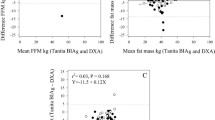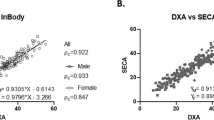Abstract
Objectives
To compare measures of fat-free mass (FFM) by three different bioelectrical impedance analysis (BIA) devices and to assess the agreement between three different equations validated in older adult and/or overweight populations.
Design
Cross-sectional study.
Setting
Orthopaedics ward of Brisbane public hospital, Australia.
Participants
Twenty-two overweight, older Australians (72 yr ± 6.4, BMI 34 kg/m2 ± 5.5) with knee osteoarthritis.
Measurements
Body composition was measured using three BIA devices: Tanita 300-GS (foot-to-foot), Impedimed DF50 (hand-to-foot) and Impedimed SFB7 (bioelectrical impedance spectroscopy (BIS)). Three equations for predicting FFM were selected based on their ability to be applied to an older adult and/ or overweight population. Impedance values were extracted from the hand-to-foot BIA device and included in the equations to estimate FFM.
Results
The mean FFM measured by BIS (57.6 kg ± 9.1) differed significantly from those measured by foot-to-foot (54.6 kg ± 8.7) and hand-to-foot BIA (53.2 kg ± 10.5) (P < 0.001). The mean ± SD FFM predicted by three equations using raw data from hand-to-foot BIA were 54.7 kg ± 8.9, 54.7 kg ± 7.9 and 52.9 kg ± 11.05 respectively. These results did not differ from the FFM predicted by the hand-to-foot device (F = 2.66, P = 0.118).
Conclusions
Our results suggest that foot-to-foot and hand-to-foot BIA may be used interchangeably in overweight older adults at the group level but due to the large limits of agreement may lead to unacceptable error in individuals. There was no difference between the three prediction equations however these results should be confirmed within a larger sample and against a reference standard.
Similar content being viewed by others
References
Ricciardi, R. and L.A. Talbot, Use of bioelectrical impedance analysis in the evaluation, treatment, and prevention of overweight and obesity. Journal of the American Academy of Nurse Practitioners, 2007. 19(5): p. 235–241.
Stallmann-Jorgensen, I.S., et al., General and visceral adiposity in black and white adolescents and their relation with reported physical activity and diet. International Journal of Obesity, 2007. 31(4): p. 622–629.
Remsberg, K.E. and R.M. Siervogel, A life span approach to cardiovascular disease risk and aging: the Fels Longitudinal Study. Mechanisms Of Ageing And Development, 2003. 124(3): p. 249–257.
Buchholz, A., C. Bartok, and D. Schoeller, The validity of bioelectrical impedance models in clinical populations. Nutrition in Clinical Practice, 2004. 19(5): p. 433–446.
Guida, B., et al., Bioelectrical impedance analysis and age-related differences of body composition in the elderly. Nutrition, Metabolism and Cardiovascular Diseases, 2007. 17: p. 175–180.
Kyle, U.G., et al., Bioelectrical impedance analysis-part II: utilization in clinical practice. Clinical Nutrition (Edinburgh, Scotland), 2004. 23(6): p. 1430–1453.
Lasser, S., et al., Evaluation of two foot-to-foot bioelectrical impedance analysers to assess body composition in overweight and obese adolescents. British Journal of Nutrition, 2003. 90: p. 987–992.
Demura, S., S. Sato, and T. Kitabayashi, Percentage of total body fat as estimated by three automatic bioelectrical impedance analyzers. Journal Of Physiological Anthropology And Applied Human Science, 2004. 23(3): p. 93–99.
Barbosa-Silva, M.C.G. and A.s.J.D. Barros, Bioelectrical impedance analysis in clinical practice: a new perspective on its use beyond body composition equations. Current Opinion In Clinical Nutrition And Metabolic Care, 2005. 8(3): p. 311–317.
Heymsfield, S., et al., Techniques used in the measurement of body composition: an overview with emphasis on bioelectrical impedance analysis. American Journal of Clinical Nutrition, 1996. 64(3S): p. 478S–484.
Kyle, U.G., et al., Bioelectrical impedance analysis—part I: review of principles and methods. Clinical Nutrition (Edinburgh, Scotland), 2004. 23(5): p. 1226–1243.
Kyle, U.G., et al., Single prediction equation for bioelectrical impedance analysis in adults aged 20–94 years. Nutrition (Burbank, Los Angeles County, Calif.), 2001. 17(3): p. 248–253.
Roubenoff, R., et al., Application of Bioelectrical Impedance Analysis to Elderly Populations. The Journals of Gerontology, 1997. 52A(3): p. M129–M136.
Dey, D.K. and I. Bosaeus, Comparison of bioelectrical impedance prediction equations for fat-free mass in a population-based sample of 75 y olds:: The NORA study. Nutrition, 2003. 19(10): p. 858.
Coppini, L., D. Waitzberg, and A. Campos, Limitations and validation of bioelectrical impedance analysis in morbidly obese patients. Current Opinion In Clinical Nutrition And Metabolic Care, 2005. 8: p. 329–332.
Segal, K.R., et al., Lean body mass estimation by bioelectrical impedance analysis: a foursite cross-validation study. American Journal of Clinical Nutrition, 1988. 47(7): p. 7–14.
Ward, L.C., et al. Constancy of resistivity coefficients for bioimpedance spectroscopy (BIS). in 8th International Symposium on In Vitro Body Composition Studies. 2008. New York, USA [Abstract].
Bland, J.M. and D.G. Altman, Statistical methods for assessing agreement between two methods of clinical measurement. Lancet, 1986. 1(8476): p. 307–310.
Ritchie, J., C. Miller, and H. Smiciklas-Wright, Tanita Foot-to-Foot Bioelectrical Impedance Analysis System Validated in Older Adults. Journal of the American Dietetic Association, 2005. 105: p. 11617–11619.
Isenring, E., et al., Evaluation of foot-to-foot bioelectrical impedance analysis for the prediction of total body water in oncology outpatients receiving radiotherapy. European Journal of Clinical Nutrition, 2004. 58(1): p. 46–51.
Bolanowski, M. and B.E. Nilsson, Assessment of human body composition using dualenergy x-ray absorptiometry and bioelectrical impedance analysis. Medical Science Monitor: International Medical Journal Of Experimental And Clinical Research, 2001. 7(5): p. 1029–1033.
Varady, K.A., S. Santosa, and P.J.H. Jones, Validation of hand-held bioelectrical impedance analysis with magnetic resonance imaging for the assessment of body composition in overweight women. American Journal Of Human Biology: The Official Journal Of The Human Biology Council, 2007. 19(3): p. 429–433.
Moon, J., et al., Total body water estimations in healthy men and women using bioimpedance spectroscopy: a deuterium oxide comparison. Nutrition and Metabolism, 2008. 5(7).
Tengvall, M., et al., Body composition in the elderly: Reference values and bioelectrical impedance spectroscopy to predict total body skeletal muscle mass. Clinical Nutrition (Edinburgh, Scotland), 2008: p. 1–7.
Isenring, E., S. Capra, and J. Bauer, Nutrition intervention is beneficial in oncology outpatients receiving radiotherapy to the gastrointestinal or head and neck area. British Journal of Cancer, 2004. 91: p. 447–452.
Barber, M., et al., Fish oil enriched nutritional supplement attenuates progression of the acute-phase response in weight-losing patients with advanced pancreatic cancer. Journal of Nutrition, 1999a. 129: p. 1120–1125.
Barber, M., et al., The effect of an oral nutritional supplement enriched with fish oil on weightloss in patients with pancreatic cancer. British Journal of Cancer, 1999b. 81: p. 80–86.
Author information
Authors and Affiliations
Corresponding author
Additional information
RR was the primary data collector and main author of the manuscript and assisted in statistical analysis and interpretation as part of the requirements for a Bachelor of Health Science (Honours). EI initiated and supervised the project and assisted in data analysis and interpretation and in writing the manuscript. LD initiated and supervised the project and assisted in writing the manuscript.
Rights and permissions
About this article
Cite this article
Ramsey, R., Isenring, E. & Daniels, L. Comparing measures of fat-free mass in overweight older adults using three different bioelectrical impedance devices and three prediction equations. J Nutr Health Aging 16, 26–30 (2012). https://doi.org/10.1007/s12603-011-0085-6
Received:
Accepted:
Published:
Issue Date:
DOI: https://doi.org/10.1007/s12603-011-0085-6




